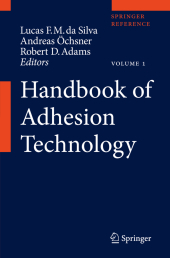 Neuerscheinungen 2011Stand: 2020-01-07 |
Schnellsuche
ISBN/Stichwort/Autor
|
Herderstraße 10
10625 Berlin
Tel.: 030 315 714 16
Fax 030 315 714 14
info@buchspektrum.de |

Robert D. Adams, Lucas Filipe Martins da Silva, Andreas Öchsner, Lucas F. M. da Silva
(Beteiligte)
Handbook of Adhesion Technology
Herausgegeben von Silva, Lucas F. M. da; Öchsner, Andreas; Adams, Robert D.
2011. xlviii, 1554 S. 476 SW-Abb., 359 Farbabb.,. 23,5 cm
Verlag/Jahr: SPRINGER, BERLIN 2011
ISBN: 3-642-01168-3 (3642011683)
Neue ISBN: 978-3-642-01168-9 (9783642011689)
Preis und Lieferzeit: Bitte klicken
This new Springer publication, part of its highly respected series of Major Reference Works, will be the definitive reference on adhesion. User-friendly yet comprehensive, it is a valuable aid to scientists and engineers in a host of separate disciplines.
Adhesives have been used for thousands of years, but until 100 years ago, the vast majority was from natural products such as bones, skins, fish, milk, and plants. Since about 1900, adhesives based on synthetic polymers have been introduced, and today, there are many industrial uses of adhesives and sealants. It is difficult to imagine a product-in the home, in industry, in transportation, or anywhere else for that matter-that does not use adhesives or sealants in some manner.
The Handbook of Adhesion Technology is intended to be the definitive reference in the field of adhesion. Essential information is provided for all those concerned with the adhesion phenomenon. Adhesion is a phenomenon of interest in diverse scientific disciplines and of importance in a wide range of technologies. Therefore, this handbook includes the background science (physics, chemistry and materials science), engineering aspects of adhesion and industry specific applications. It is arranged in a user-friendly format with ten main sections: theory of adhesion, surface treatments, adhesive and sealant materials, testing of adhesive properties, joint design, durability, manufacture, quality control, applications and emerging areas. Each section contains about five chapters written by internationally renowned authors who are authorities in their fields.
This book is intended to be a reference for people needing a quick, but authoritative, description of topics in the field of adhesion and the practical use of adhesives and sealants. Scientists and engineers of many different backgrounds who need to have an understanding of various aspects of adhesion technology will find it highly valuable. These will include those working in research or design, as well as others involved with marketing services. Graduate students in materials, processes and manufacturing will also want to consult it.
Preface
Introduction to adhesive bonding technology
Part A - Theory of Adhesion
Forces involved in adhesion
Wetting
Work of adhesion
Spreading
Theories of adhesion
Part B - Surface treatments
Surfaces
General principles
Surface treatments
Surface assessment
Primers and adhesion promoters
Surface treatments of selected materials
Part C - Adhesive and sealant materials
Classification
Composition
Adhesive families
Sealant families
Selection
Part D - Testing of adhesive properties
Physical properties
Thermal properties
Failure strength tests
Fracture tests
Impact tests
Special tests
Part E - Joint design
Constitutive adhesive and sealant models
Analytical approach
Numerical approach
Special numerical techniques
Design rules and methods to improve joint strength
Design with sealants
Design for impact loads
Vibration damping
Part F - Durability
High and low temperature effects
Humidity, water and chemicals
Radiation and vacuum
Fatigue load conditions
Creep load conditions
Combined temperature-moisture-mechanical stress effects
Part G - Manufacture
Storage
Preparation
Application
Bonding equipment
Environment and safety
Part H - Quality control
Quality control of raw materials
Processing quality control
Non-destructive testing
Techniques for post-fracture analysis
Part I - Applications
Aeronautical industry
Aerospace industry
Automotive industry
Rail industry
Boats and marine
Civil construction
Electrical
Shoe industry
Part J - Emerging areas
Molecular dynamics simulation and molecular orbital method
Bioadhesion
Bioadhesives
Adhesives with nanoparticles
Adhesion in medicine
Adhesion in energy applications
Recycling and environmental aspects
Epilogue


